Vaccines: Market on the Rebound
Pharmaceutical Executive
Mergers have cut the field of companies with real marketing and manufacturing muscle from 25 to five. The 2004 vaccine market will double by 2009.
Vaccines used to be far less attractive than other pharmaceutical markets. As a mature product group that relied on a limited set of technologies and didn't generate strong revenues, the therapeutic area languished for decades. Companies were constrained by government price controls or, in some cases, by direct state manufacturing control. In many countries—often those that need vaccines most—few doses could be sold because payers had no money. Companies limited investment, and as a result, technological innovation lagged behind other pharmaceutical sectors.
But over the past decade, several trends converged to revive the market. Among investors and the broader public, vaccines are suddenly hot. New vaccines have been introduced to replace older ones, and innovative products are taking aim at unmet medical needs—all of which improve the pricing environment. Producers have consolidated, so that a handful of companies with real manufacturing and marketing muscle control the field. And the public sector has begun to institute policies that spur investment and therapeutic innovation. In 2004, President George W. Bush signed legislation adding the flu vaccine to the Vaccine Injury Compensation Program. More recently, the president has called for broader liability protection for vaccine manufacturers. Not least important, the non-profit sector—led by the Bill & Melinda Gates Foundation—has fostered public–private partnerships that enable vaccines to penetrate markets in poorer nations. The result: a new wave of investment in vaccines.
Big Changes
The first noticeable change in the domestic vaccine market over the past 25 years is an increase in pricing. For example, a diphtheria, tetanus, and pertussis (DTP) treatment course that was priced at roughly 30 cents in 1980 now costs $20, in part because a new acellular pertussis antigen was added. More important, vaccine manufacturers are increasingly able to capitalize on new products, with some emerging vaccines priced at $300 or more per treatment course.
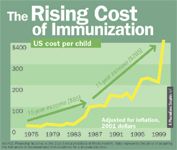
The Rising Cost of Immunization
More on-schedule vaccines and higher prices have led to a 40-fold increase over the past 20 years in cumulative annual expenditures (the amount spent on a child during the first six years of life) on childhood immunizations in the United States. Adjusted for inflation, the annual spend per child has risen from less than $10 in the early 1980s to approximately $400 today (see "The Rising Cost of Immunization").

Blockbuster Potential
In fact, the vaccine field has a blockbuster. Wyeth's pneumoccocal conjugate vaccine, Prevnar, reached sales of $700 million in the United States within 15 months of launch, and tallied sales of almost $1.5 billion worldwide in 2005 (see "Blockbuster Potential"). Prevnar was the first vaccine to rank among the top-10 new product launches for a major pharmaceutical company, and it quickly established itself among the top-three products in Wyeth's portfolio. In the wake of Prevnar, companies will release at least seven potential blockbuster products (for human papillomavirus, or HPV; rotavirus; meningitis prophylaxis; pneumococcal disease; and herpes simplex) over the next three years (see "Major Vaccines on the Way").
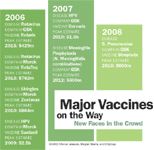
Major Vaccines on the Way.
Industry consolidation also has improved vaccine prospects. Mergers have winnowed a field of more than 25 smaller players into five major manufacturers: GlaxoSmithKline (GSK), Merck, Sanofi Pasteur, Chiron, and Wyeth. These firms are big enough to achieve attractive returns on vaccines. Profit margins for the vaccine units of these companies are comparable with those in their core pharmaceutical businesses.
For example, EBITDA margins (earnings before interest, tax, depreciation and amortization, a proxy for cash flow) for the vaccine division of GSK Biologicals are in the low 40-percent range, compared with 35 percent in its other businesses. Because of higher capital expenditures (and the resulting depreciation expense), the margin deteriorates at the EBIT level to 26 percent, but it remains close to the 30-percent margin of the core business.
Besides these pricing and scale issues, the public sector is taking substantive steps to spur development of new vaccines and creation of capacity for existing vaccines. In high-income countries, bioterrorism and pandemic flu initiatives are fueling private-sector investment. Governments are issuing long-term purchasing contracts, and increased funding has become available for discovery.
In poorer nations, public and non-profit support is helping to create a viable market. The Bill & Melinda Gates Foundation has led the way, giving over $1.5 billion to form and develop the Global Alliance for Vaccines and Immunization (GAVI). Typical of the initiatives funded by GAVI and the Gates Foundation is the Malaria Vaccine Initiative, which has partnered with GSK to develop a malaria vaccine for poorer nations, in a fashion that benefits all parties.
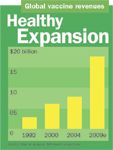
Healthy Expansion
New Investment
The improved financial environment has not been lost on pharmaceutical companies, biotechnology firms, and the broader investment community. The vaccine market is expected to more than double between 2004 and 2009 (see "Healthy Expansion"). Increased R&D spending has helped fill the pipelines of the major vaccine companies (see "Pipeline for the Leading Manufacturers").
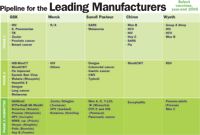
Pipeline for the Leading Manufacturers
Promising candidates are in development in a variety of disease areas, including HPV, also known as the cervical-cancer vaccine; herpes simplex virus; influenza; HIV; and severe acute respiratory syndrome (SARS). In addition, companies are working on defense-oriented products, such as anthrax and smallpox vaccines. Analysts project that 75 percent of Merck's vaccine business will be composed of new products over the next five years. As a result of this activity, vaccines are expected to make up a growing share of the total revenue of major firms. At Merck, for example, vaccines should grow from less than five percent of revenues today to more than 16 percent by 2009 (see "A Growing Part of the Portfolio").
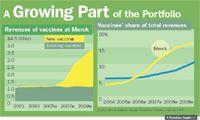
A Growing Part of the Portfolio
Smaller players are seizing opportunities as well. ID Biomedical (recently acquired by GSK Biologicals), Acambis, Avant Immunotherapeutics, and other biotechnology firms have developed a thriving discovery role as the market expands. Avant discovered and developed a rotavirus compound and licensed it to GSK. These biotechnology players are also applying vaccine technologies to non-traditional therapeutic areas. For example, Avant is working on a cholesterol-control product. Beyond discovery, players have been innovating in other aspects of vaccine technology as well. Over the past 50 years, simple alum has been the dominant adjuvant, the additional ingredient that facilitates the action of the antigen in a vaccine. Today, companies such as Corixa, Coley Pharmaceutical Group, and CSL Limited are developing new adjuvants that may revolutionize the field. Other biotechnology and medical device firms are also creating new production mediums and delivery mechanisms.
Opportunities and Challenges
While the outlook for vaccines is quite positive, senior industry executives face four high-stakes issues as they build their vaccine businesses:
- Business design choices
- Go-to-market strategy
- Global market opportunities
- Alignment of product development with operational strategy
Business design choices Every company makes explicit or implicit choices about the design of its business model, and vaccine market participants have employed a variety of business designs. Some pursue a broad, nearly global set of customers, whereas others focus on a particular country or population segment. Some capture value through segmented pricing across a high base of volume, whereas others achieve high pricing on a limited set of products with relatively low volume. Some use scale as a strategic control lever, while others employ technology or first-mover advantage.
When a market is relatively stable, business designs can endure and succeed for a long time. However, major changes in a market, such as those occurring in vaccines, can render existing business designs obsolete. This requires incumbents and new entrants to consider (or reconsider) the design choices they have made.
One of these choices is the basis on which they will compete. In the old vaccine paradigm, companies tended to compete by being first to market, achieving licensure, convincing governments to recommend the use of their new product, and facilitating physician and patient education. However, in the new vaccine era, that paradigm is changing, as new products are less likely to enter the market with limited competition, given the growing pipelines of products targeting a wide range of disease areas. In this more dynamic environment, companies will have to determine how to compete along other dimensions, such as product differentiation. The inter-pandemic influenza market is a good example of this trend, as nearly 10 products using different technologies and delivery systems are currently in development by companies including Baxter, GSK, and Chiron.
The Internet is encouraging patients and parents to play a more prominent role in vaccination decisions. In a 2003 survey of US pediatricians, over half indicated that parental concerns about general vaccine side-effects, as well as past intussusception issues with Rotashield (Wyeth's withdrawn Rotavirus vaccine, the first of its kind), would make reintroduction of a Rotavirus vaccine difficult. Valid or not, parental concerns about thimerosal, links to autism, and adverse side effects will affect uptake and need to be addressed.
In light of these developments, vaccine market participants need to carefully consider the age groups they target, and the way they position products in the minds of patients and influencers. In addition, they need to think carefully about the make-up of their product portfolio and the allocation of R&D spending.
Focused technology firms, for their part, must carefully consider which advancements will improve their customers' systems economics. For example, a biotech's decision about whether to develop a new viral or bacterial production medium will hinge not only on how much this innovation can improve yields in the bulk production process, but also on how such improvements solve specific problems for vaccine manufacturers—including capacity constraints, quality issues, and cost positions.
Go-to-market strategy Many emerging vaccine pipeline candidates look nothing like traditional products. Some target adolescents and adults rather than children. Others aim to enhance quality of life, rather than preventing diseases with limited treatment options and life-threatening consequences. More than a few raise sensitive issues—in particular, the sexual activity of young women—and will require difficult conversations among doctors, patients, and their families. In addition, some of these new products will likely be off schedule, leaving greater discretion to physicians and patients, and posing additional reimbursement challenges.
Consider the experience of MedImmune in 2003, when it launched FluMist, a live, attenuated flu vaccine. A highly efficacious product that is administered nasally, FluMist represented a real innovation. The timing of launch was fortuitous as well, given supply shortfalls in the traditional killed vaccine. Nonetheless, initial results fell far short of expectations, as MedImmune sold roughly 20 percent of the doses it produced for the 2003 to 2004 flu season. While product-design features (e.g., refrigeration requirements) played a role, so did the go-to-market strategy: Prices were set at twice that of traditional vaccines, while an expensive, mass-market campaign did not raise sufficient product awareness. And distributing the new vaccine primarily through pharmacies instead of doctor's offices constrained availability. The new HPV by Merck and GSK will require creative, proactive go-to-market strategies as well.
Global market opportunities As governments worldwide commit more funding to vaccine procurement, and support for vaccines in lower-income countries grows, a global vaccine market is emerging. But many of the most threatening diseases in the developing world, such as malaria and cholera, barely afflict high-income countries. So vaccine companies cannot recoup R&D costs in high-income countries and then discount the product to lower-income markets. Early pioneers in these markets have formed development partnerships, such as the one between GSK and the Gates Foundation's Malaria Vaccine Initiative, but the winning model has yet to be determined. Moreover, even when diseases are found in regions with varying income levels, significant differences often exist, both in terms of the nature of the disease (e.g., which serotypes are present) and the vaccine characteristics appropriate across markets, such as cost, efficacy, and side-effects. For example, most high-income markets have a DTP vaccine that contains an acellular pertussis antigen; many lower- and middle-income markets want one with whole-cell pertussis. The polio vaccine market varies along the same lines.
So companies seeking to address global markets must decide if they want to develop a single vaccine applicable to all regions or develop separate vaccines in parallel or in sequence. This can be a difficult decision with many tradeoffs. Companies considering these opportunities must evaluate the impact of different product designs on the likelihood of successful development, time-to-market, and the value of first-mover advantage. In addition to product features (e.g., the number of serotypes addressed by the vaccine), companies will need to decide whether to apply existing manufacturing processes or to develop new processes that might be more efficient in the long-term. While this may seem purely operational, this decision can dictate the markets a company is able to pursue, particularly if the existing process is inefficient and results in higher production costs and constrained capacity. In such situations, the company may have priced its products out of middle-income and lower-income markets.
Alignment of product development with operational strategy Traditionally, vaccine companies have maintained two separate decision making tracks. Product-development personnel determine a vaccine's characteristics with limited involvement early on by the operations staff. Since decisions made by R&D teams as early as pre-clinical stages of development often place serious constraints on manufacturing options, the resulting cost and capacity characteristics may not be appropriate given market conditions. For example, the R&D team may choose to increase the dosage of a particular vaccine from 25 mcg to 50 mcg instead of using a more complex adjuvant to increase efficacy. This reduces effective capacity at the bulk-production step by 50 percent for any given fermenter size.
For relatively simple vaccine technologies with low annual demand, a margin of error lessened the impact of such decisions––a single fermenter might have been able to meet the entire annual demand for the vaccine and still have excess capacity. But manufacturing decisions will have a greater impact on the economics of new vaccines with more complex production processes and demand levels of, say, 25 million doses. For example, companies need to consider the manufacturing and capacity costs of various combinations of dosage and adjuvants for a new vaccine. In most cases, the efficiency of the manufacturing process will change the cost-benefit ratio of the drug, so manufacturing engineers need to have a say earlier in the development process. If antigen expression and yields are high, larger dosages will have a limited impact on capacity and cost. But the converse is also true (see "Product Design and Manufacturing Economics").
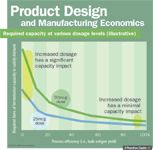
Product Design and Manufacturing Economics
Product features and operational realities affect cost and capacity, so companies need to link marketing, product design, and operations—even choosing a different technology, adjuvant, or dosage—in order to benefit the economics of the vaccine.
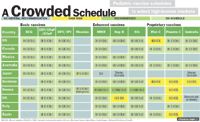
A Crowded Schedule
The new wave of vaccine products represents enormous profit potential for companies and investors, as well as the opportunity to benefit millions of people. But companies will need to rethink their strategies and go-to-market approaches. That's what it will take to keep the vaccine market hot.
Andrew Pasternak, a Chicago-based director, Adam Sabow, a Chicago-based principal, and Andrew Chadwick-Jones, a London-based principal, are with Mercer Management Consulting. They can be reached at andrew.pasternak@mercermc.comadam.sabow@mercermc.com and andrew.chadwickjones@mercermc.com

FDA Grants Priority Review to Regeneron’s Eylea for Macular Edema Following Retinal Vein Occlusion
April 18th 2025Regulatory action was based on data from the Phase III QUASAR trial, which demonstrated that Eylea HD dosed every eight weeks achieved non-inferior visual acuity outcomes compared to Eylea in patients with macular edema following retinal vein occlusion.
Addressing Disparities in Psoriasis Trials: Takeda's Strategies for Inclusivity in Clinical Research
April 14th 2025LaShell Robinson, Head of Global Feasibility and Trial Equity at Takeda, speaks about the company's strategies to engage patients in underrepresented populations in its phase III psoriasis trials.
New Insights Into T Cell Exhaustion and Inflammation in Long COVID
April 17th 2025Nigel McCracken, chief operating officer, Virax Biolabs, discusses new findings that reveal altered cytokine activity and evidence of T cell exhaustion in long COVID patients, providing deeper insight into post-infection immune disruption.
Key Findings of the NIAGARA and HIMALAYA Trials
November 8th 2024In this episode of the Pharmaceutical Executive podcast, Shubh Goel, head of immuno-oncology, gastrointestinal tumors, US oncology business unit, AstraZeneca, discusses the findings of the NIAGARA trial in bladder cancer and the significance of the five-year overall survival data from the HIMALAYA trial, particularly the long-term efficacy of the STRIDE regimen for unresectable liver cancer.
Amgen’s Imdelltra Demonstrates Significant Overall Survival Improvement in Small Cell Lung Cancer
April 16th 2025In the Phase III DeLLphi-304 trial, patients with small cell lung cancer administered Imdelltra achieved a statistically significant and clinically meaningful improvement in overall survival compared to standard-of-care chemotherapy.